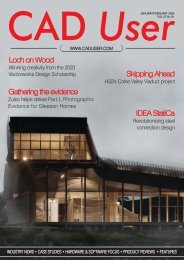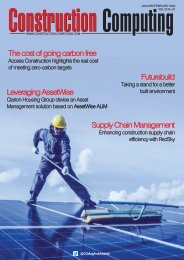Create successful ePaper yourself
Turn your PDF publications into a flip-book with our unique Google optimized e-Paper software.
TE3CHNOLOGYfocus<br />
Visualising carbon<br />
3D Repo provides an API that allows designers to view embodied carbon within the building<br />
components and methods of construction in their 3D models<br />
Hosted by 3D Repo and codelivered<br />
by ZERO, the recent<br />
online webinar 'Visualising<br />
Carbon: BIM to Zero'' explained how<br />
embodied carbon can be visualised<br />
within construction models, enabling<br />
architects and engineers to make<br />
informed choices about what building<br />
materials they use and the building<br />
processes they adopt based on the<br />
amount of embodied carbon within each.<br />
ZERO are a group of construction<br />
industry professionals who were taking<br />
part in the webinar to highlight the major<br />
issues facing the planet from the point<br />
of view of a not-for-profit, independent<br />
group of self-styled next generation<br />
radicals, relating our current situation to<br />
their futures as potential leaders within<br />
the industry. Launched by James<br />
Bowles, 4D Consultant at Freeform, in<br />
2001, the group now has 400 members<br />
based in 40 countries worldwide. ZERO<br />
sponsors events and working groups<br />
and is building a low carbon playbook,<br />
where working groups have been<br />
focusing on individual topics to provide<br />
practical guidance for people working<br />
on low carbon projects, enabling<br />
members to explore solutions and foster<br />
the adoption of significant actions which<br />
could have an immediate impact on an<br />
individual project's CO2e (embodied<br />
carbon) levels.<br />
Putting that in context, James<br />
explained that the construction industry<br />
emits 4 billion tonnes of CO2e annually -<br />
equivalent to 12% of all human-related<br />
emissions. This combines data from all<br />
of the processes involved in<br />
construction, from mining and extraction<br />
to processing and manufacture,<br />
assembly, transport from its source and<br />
to the construction site, construction<br />
processes - in fact, all emissions during<br />
a building's lifecycle and its eventual<br />
demolition or repurposing.<br />
Leveraging the expertise within their<br />
group, ZERO offers advice in all areas:<br />
designing with embodied carbon in<br />
mind; tools available for embodied<br />
carbon measurement; how to develop<br />
awareness and upskill people;<br />
technology innovations and low carbon<br />
methods of construction. Going further,<br />
they want to change people's mindsets,<br />
get clients to insert CO2e related<br />
clauses into contracts, and set targets<br />
and promote dialogues by sharing<br />
success or failure.<br />
James was joined by Tasha Greenfield,<br />
a Design Coordinator at Natural Building<br />
Systems and a co-leader of the ZERO<br />
Next group. With access to all available<br />
sources of information about carbon<br />
emissions, ZERO were able to provide<br />
some striking and quite alarming<br />
statistics, such as that the built<br />
environment contributes around 39% of<br />
total global emissions, 31% of which are<br />
materials. Figures from the Institute of<br />
Structural Engineers (IstructE) show that<br />
one return economy flight to New York<br />
emits 1000Kg of CO2e, and if we<br />
stopped driving cars we would each<br />
save 3000Kg CO2e per annum. You can<br />
view the full presentation on YouTube<br />
here: https://youtu.be/jbwhK0oScBE<br />
Besides IstructE, other suppliers of<br />
carbon data include Building<br />
Transparency, who have developed the<br />
Embodied Carbon in Construction<br />
Calculator (EC3) - a free database of<br />
construction EPDs Environmental<br />
Product Declarations (EPD) defined by<br />
ISO 14025 that 'quantifies environmental<br />
information on the lifecycle of a product<br />
to enable comparisons between<br />
products fulfilling the same function'.<br />
The CIC Carbon Assessment Tool is<br />
similar, developed to create a common<br />
platform for evaluating the carbon<br />
performance of buildings and<br />
infrastructure in Hong Kong from raw<br />
material extraction to the end of<br />
construction.<br />
Closer to home, Professor Geoff<br />
Hammond and Craig Jones, from the<br />
Sustainable Energy Research Team<br />
(SERT) at the University of Bath, are<br />
behind the Inventory of Carbon and<br />
Energy (ICE), which has been providing<br />
an online source of data for embodied<br />
energy and carbon of construction<br />
materials since 2006.<br />
There is a variety of tools for measuring<br />
CO2e but, as Tasha suggested, it's early<br />
days and processes are still being<br />
evaluated and refined. Even the EC3<br />
User Guide is a work in progress.<br />
14<br />
<strong>Jul</strong>y/<strong>Aug</strong>ust <strong>2022</strong>

















